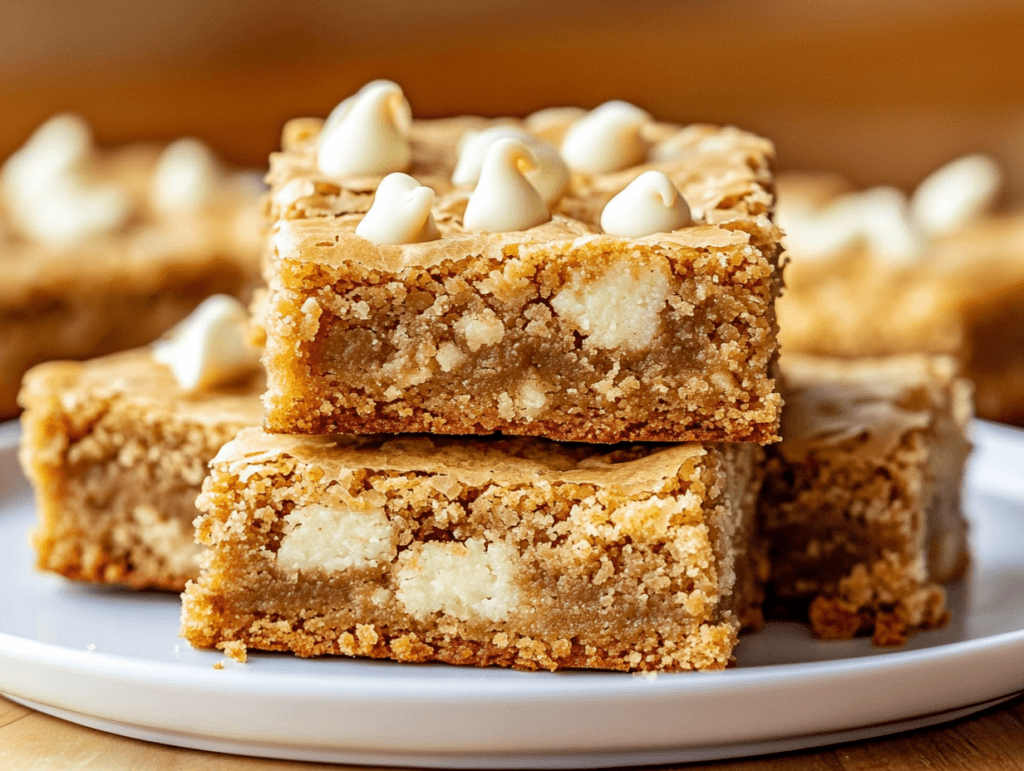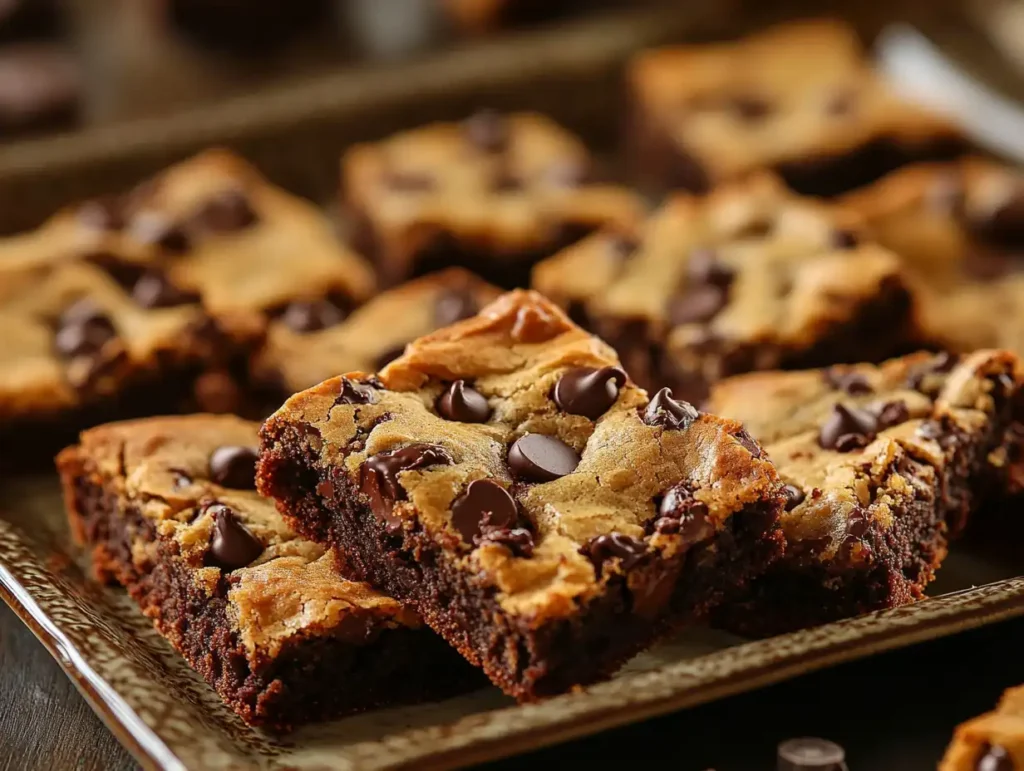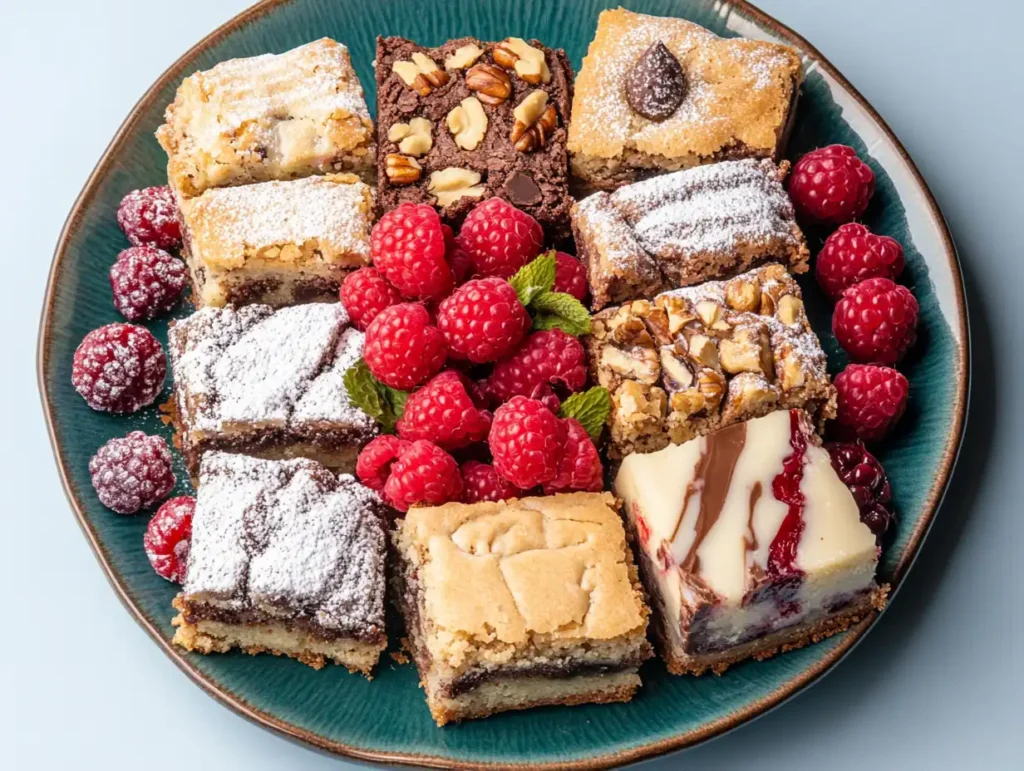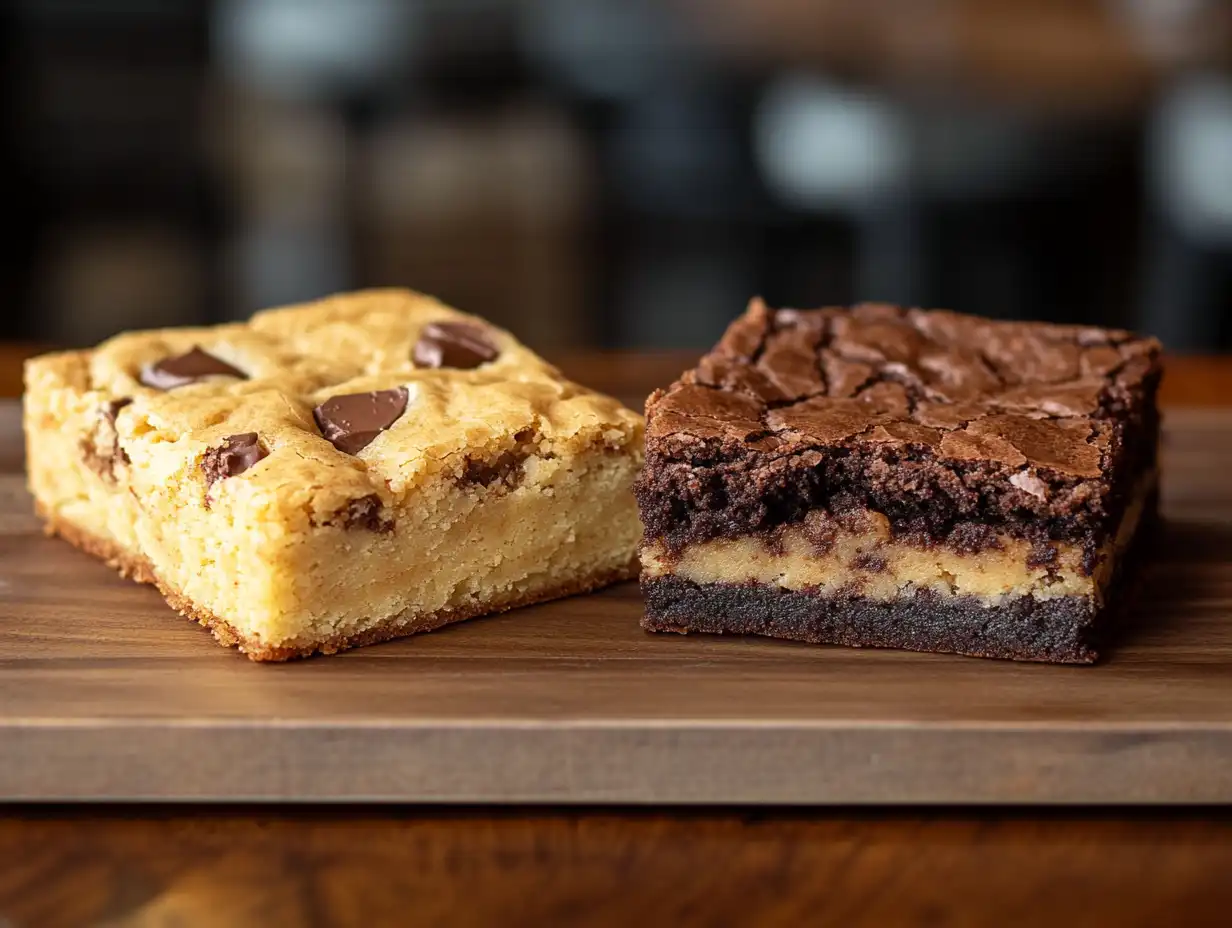Whats the difference between a blondie and a brookie ? Desserts have always held a special place in our hearts, satisfying sweet cravings and adding joy to countless occasions. Among the wide array of desserts, blondies and brookies have emerged as favorites for those who love chewy, rich, and chocolate-infused treats. Yet, despite their popularity, these two indulgent baked goods often confuse even the most ardent dessert lovers. What’s the difference between a blondie and a brookie? Are blondies simply pale brownies? Are brookies just brownies with extra flair? Understanding the differences between these two desserts can help you choose the perfect treat for your mood and taste.
This article delves into the world of blondies and brookies, answering the question, “What’s the difference between a blondie and a brookie?” We’ll explore their unique characteristics, ingredients, and preparation methods. By the end, you’ll have a clear understanding of what makes these treats distinct, their similarities, and how they fit into the broader world of baked desserts. What’s the difference between a blondie and a brookie? Let’s start by defining what a blondie is and how it’s made.
Table of Contents
What’s the Difference Between a Blondie and a Brookie?
What is a Blondie?
Definition of a Blondie
A blondie, often referred to as a “blonde brownie,” is a chewy and rich dessert bar that shares similarities with the classic brownie but has its own distinct identity. Unlike brownies, which derive their signature dark color and chocolatey flavor from cocoa powder or melted chocolate, blondies rely on brown sugar and vanilla as their primary flavoring agents. The result is a dessert that is sweet, buttery, and slightly caramel-like in taste.
Ingredients in a Blondie
The core ingredients of a blondie are simple, yet they combine to create a truly delightful treat. These include:
- Flour: Typically all-purpose flour for structure.
- Brown Sugar: Adds a deep caramel flavor and a chewy texture.
- Butter: Provides richness and moisture.
- Eggs: Help bind the ingredients and give the blondie its structure.
- Vanilla Extract: Infuses the blondie with warm, aromatic notes.
- Add-ins (Optional): Chocolate chips, nuts, or dried fruit can be mixed in for added texture and flavor.
Texture and Flavor Profile of Blondies
Blondies are known for their chewy and dense texture, which can vary slightly depending on the recipe. Their flavor is often described as buttery and caramel-like, thanks to the high content of brown sugar. Unlike the intense chocolate flavor of a brownie, blondies offer a more subtle sweetness, making them a versatile dessert option.

How Blondies Are Prepared
Blondies are one of the easiest desserts to bake, making them a favorite for both novice and experienced bakers. The preparation involves:
- Mixing the Wet Ingredients: Creaming together butter and brown sugar until light and fluffy, followed by adding eggs and vanilla extract.
- Incorporating the Dry Ingredients: Gradually adding flour, along with any leavening agents like baking powder or baking soda.
- Adding Mix-Ins: Stirring in optional ingredients such as chocolate chips or nuts.
- Baking: Spreading the batter into a greased or parchment-lined baking pan and baking at 350°F (175°C) until the edges are golden brown and the center is set.
Blondies can be cut into squares or rectangles for serving and are often enjoyed on their own or paired with coffee or ice cream.
What is a Brookie?
Definition of a Brookie
A brookie is the delicious offspring of two iconic desserts: the brownie and the cookie. Combining the rich, fudgy decadence of a brownie with the chewy, buttery goodness of a chocolate chip cookie, a brookie is a hybrid treat that brings together the best of both worlds. Typically, brookies feature distinct layers of brownie batter and cookie dough, baked together to create a dessert that’s as visually striking as it is flavorful.
Ingredients in a Brookie
Brookies combine the essential ingredients of both brownies and cookies, resulting in a dessert that’s indulgent and versatile. The standard recipe includes:
- For the Brownie Layer:
- Cocoa powder or melted chocolate for deep chocolate flavor.
- Sugar, eggs, butter, and flour for structure and richness.
- For the Cookie Layer:
- Brown sugar and white sugar for sweetness and chewiness.
- Butter, eggs, and vanilla extract for flavor.
- Flour, baking soda, or powder for texture.
- Chocolate chips or chunks for gooeyness.
Texture and Flavor Profile of Brookies
Brookies stand out due to their layered texture. The brownie layer contributes a dense and fudgy base, while the cookie layer adds a light, chewy, and slightly crisp top. The combination results in a dessert that offers contrasting textures in every bite. Flavor-wise, brookies marry the chocolate intensity of brownies with the buttery sweetness of chocolate chip cookies, making them a hit among dessert enthusiasts.
How Brookies Are Prepared
While brookies may sound complex, they’re surprisingly simple to make. The process involves:
- Preparing the Brownie Batter: Mixing the ingredients for a standard brownie batter, which will form the base layer.
- Preparing the Cookie Dough: Whipping up a classic chocolate chip cookie dough, which will be layered on top of the brownie batter.
- Layering the Two: Spreading the brownie batter into a greased or lined pan, then carefully adding the cookie dough on top. Some recipes swirl the layers together for a marbled effect.
- Baking: Baking at a moderate temperature, typically around 350°F (175°C), until the brownie layer is set and the cookie layer is golden brown.
Brookies can be sliced into bars or squares and are often served warm to showcase their gooey textures. They pair well with milk, coffee, or even a dollop of whipped cream.If you’re looking for step-by-step instructions, check out how to assemble a brookie.

Key Differences Between Blondies and Brookies
Ingredient Differences
The first major distinction between blondies and brookies lies in their core ingredients:
- Blondies: The defining flavors come from brown sugar and vanilla, with optional mix-ins like white chocolate chips, nuts, or caramel pieces. Cocoa powder or melted chocolate is notably absent, making blondies a non-chocolate treat.
- Brookies: These are a hybrid of brownie and cookie, meaning they feature ingredients typical of both desserts. The brownie layer includes cocoa powder or chocolate, while the cookie layer incorporates brown sugar, vanilla, and chocolate chips for a buttery and chocolatey combination.
Visual Differences
Blondies and brookies also differ visually, making them easy to distinguish:
- Blondies: With their pale golden color, blondies resemble a traditional cookie in bar form. Their surface is often smooth and shiny, with occasional glimpses of mix-ins like nuts or white chocolate chips.
- Brookies: These desserts feature a dual-layer or marbled appearance. The bottom layer is dark and fudgy from the brownie batter, while the top layer is lighter, showcasing the classic golden hue of cookie dough.
Taste and Texture Comparison
Blondies and brookies offer distinctly different taste experiences:
- Taste: Blondies have a sweet, caramel-like flavor with a subtle vanilla undertone. Brookies are more complex, delivering a rich chocolate flavor from the brownie layer alongside the buttery sweetness of the cookie layer.
- Texture: Blondies are typically dense, chewy, and slightly gooey, depending on the recipe. Brookies, on the other hand, offer textural contrast with their fudgy brownie base and crisp, chewy cookie topping.
Similarities Between Blondies and Brookies
Common Ingredients
Despite their differences, blondies and brookies share several foundational ingredients, which contribute to their rich and satisfying flavors:
- Butter: Provides the richness and moist texture that both desserts are known for.
- Sugar: While blondies rely heavily on brown sugar for their caramel-like flavor, brookies use a combination of white and brown sugar in their cookie dough layer.
- Eggs: Essential for binding the ingredients and creating the dense, chewy texture characteristic of both desserts.
- Flour: Forms the structural base for both blondies and brookies.
These overlapping ingredients ensure that both desserts are indulgently rich and appealing to a wide audience.
Baking Methods
Blondies and brookies are both baked desserts, which means they share several steps in their preparation:
- Mixing Wet and Dry Ingredients Separately: Both recipes call for combining the wet ingredients (like butter and eggs) and the dry ingredients (like flour and baking soda) before folding them together.
- Even Spreading of Batter: Whether it’s a single batter (blondies) or layered batters (brookies), the mixtures are spread evenly in a prepared baking pan.
- Moderate Oven Temperature: Both desserts bake at around 350°F (175°C), ensuring a consistent cook while maintaining their soft and chewy textures.
Use of Chocolate
While chocolate is a key component of brookies, blondies are often enhanced with chocolate chips or chunks as optional mix-ins. This means that both desserts can feature chocolate elements, but they do so in unique ways:
- Blondies: Chocolate chips are often used sparingly, allowing the buttery and caramel flavors to remain dominant.
- Brookies: Chocolate is a central feature, especially in the brownie layer, creating a dessert where chocolate takes center stage.
Versatility in Add-Ins
Both blondies and brookies lend themselves to customization, allowing bakers to get creative with add-ins such as:
- Nuts: Pecans, walnuts, or almonds for crunch.
- Fruits: Dried cranberries, cherries, or even fresh raspberries for a tart contrast.
- Flavored Chips: Butterscotch, peanut butter, or white chocolate chips for additional variety.
The shared flexibility in ingredients and preparation makes both desserts beloved staples in any baker’s repertoire.
Popular Variations and Twists
Creative Takes on Blondies
Blondies, with their buttery and caramel-like flavor, serve as a blank canvas for culinary creativity. Here are some popular variations that take the classic blondie to new heights:
- Fruit-Infused Blondies:
Add dried or fresh fruits like raspberries, cranberries, or diced apples to the batter for a tart or fruity twist. These variations bring a balance of sweetness and tanginess. - Nutty Blondies:
Incorporate pecans, walnuts, or macadamia nuts for added crunch and depth of flavor. Toasting the nuts beforehand amplifies their flavor. - Chocolate Swirl Blondies:
Drizzle melted chocolate or cocoa-based batter over the blondie mixture before baking to create a marbled effect that adds a touch of chocolate without overpowering the blondie’s distinct flavor. - Spiced Blondies:
Enhance the warm notes of brown sugar with spices like cinnamon, nutmeg, or cardamom. This variation is particularly popular during the fall and winter seasons. - Salted Caramel Blondies:
Add a layer of caramel or a sprinkle of sea salt on top to create a sweet-and-savory combination that elevates the blondie’s richness.
Variations of Brookies
Brookies’ dual-layer format makes them inherently versatile. Here are some creative twists on the classic brookie recipe:
- Layered Brookies:
Instead of simply combining brownie and cookie batters, create distinct layers of different flavors, such as peanut butter cookies atop a chocolate brownie base. - Stuffed Brookies:
Embed surprises like caramel, peanut butter, or marshmallow in the center of the brookie for a gooey core. These stuffed brookies are a hit with anyone who loves molten-style desserts. - Nut-Free Brookies:
Substitute traditional brownie and cookie recipes with nut-free versions for those with allergies, ensuring everyone can enjoy this treat. - Vegan Brookies:
Use plant-based butter, aquafaba (chickpea water), and dairy-free chocolate to create a vegan-friendly version without sacrificing flavor or texture. - Gluten-Free Brookies:
Opt for almond flour or gluten-free baking mixes to make brookies suitable for those with gluten sensitivities or celiac disease.
Brookies’ dual-layer format makes them inherently versatile. For a foolproof recipe that combines the best aspects of brownies and cookies, you can visit the ultimate brookie recipe.
Trendy Twists in Bakeries and Home Kitchens
Modern bakers often take these desserts a step further with Instagram-worthy creations:
- Brookie Sandwiches: Two layers of brookie with a cream or ganache filling in between.
- Mini Blondie or Brookie Bites: Bite-sized versions, perfect for parties and events.
- Ice Cream Brookies: Pairing brookies with ice cream or even baking the brookie batter directly into ramekins as a dessert a la mode.
Both blondies and brookies have proven their adaptability, evolving beyond their traditional recipes to suit various tastes, dietary needs, and creative inspirations.
When to Choose a Blondie vs. a Brookie
Occasions for Blondies
Blondies are versatile and understated, making them suitable for a variety of occasions. Here’s when blondies might be the ideal dessert choice:
- Casual Gatherings:
Their straightforward flavors and ease of preparation make blondies perfect for potlucks, picnics, or small get-togethers. - Coffee Pairings:
With their rich, buttery taste, blondies complement a cup of coffee or tea, making them a great choice for brunches or coffee dates. - Customizable Desserts:
If you’re looking to impress guests with unique flavors, blondies can easily incorporate fruits, nuts, or spices to suit the event’s theme. - Holiday Treats:
Their warm flavors pair beautifully with festive spices, making them a hit at Thanksgiving or Christmas celebrations.
Looking for details about its components? Learn what a brookie is made of to understand how brownie layers combine with buttery cookie dough
Occasions for Brookies
Brookies, with their bold layers and indulgent textures, shine in more extravagant or playful settings:
- Celebratory Events:
Birthdays, anniversaries, and other special occasions call for a dessert that feels luxurious and indulgent, and brookies deliver on both fronts. - Dessert Bars and Buffets:
The eye-catching layered appearance of brookies makes them a visually appealing choice for dessert tables at weddings, baby showers, or corporate events. - Movie Nights or Sleepovers:
Their hybrid nature satisfies multiple cravings at once, making them perfect for casual, fun gatherings with friends or family. - Gifting:
Packed in a stylish box, brookies make for a thoughtful and gourmet-style gift for dessert enthusiasts.
Personal Taste Preferences
When it comes down to choosing between a blondie and a brookie, personal preference plays a significant role:
- For Lovers of Simplicity: Blondies, with their warm, caramel-like flavor, are perfect for those who prefer subtle sweetness and versatility.
- For Fans of Decadence: Brookies are ideal for chocolate enthusiasts and those who love bold flavors and layered textures.
Combining Both
Can’t decide? Serve both! Blondies and brookies complement each other beautifully when presented together on a dessert platter. Their contrasting flavors and textures provide variety and satisfy a wide range of palates.

Nutrition and Dietary Considerations
Caloric Differences Between Blondies and Brookies
While both desserts are indulgent, their caloric content varies depending on the ingredients and portion sizes:
- Blondies:
Blondies are typically lower in calories compared to brookies because they lack a chocolate-heavy base. However, their high content of butter and sugar can still make them calorie-dense. A standard serving (about 2-inch square) contains approximately 150–200 calories, depending on mix-ins like nuts or chocolate chips. - Brookies:
Brookies are richer and more calorically dense due to their dual-layer structure, combining both brownie and cookie components. A similar serving size can range from 250–300 calories, especially if loaded with chocolate chips or extra toppings.
For tips on enjoying sweets without guilt, check out Can You Have Dessert for Breakfast? Tips and Healthy Alternatives.
Healthier Alternatives for Blondies
Blondies can be modified to make them healthier or more diet-friendly:
- Lower Sugar: Replace some or all of the brown sugar with natural sweeteners like honey, maple syrup, or stevia.
- Whole Grains: Swap out all-purpose flour for whole wheat or almond flour to boost fiber content.
- Vegan-Friendly: Use flaxseed meal mixed with water as an egg substitute and coconut oil instead of butter.
- Portion Control: Bake blondies in a mini muffin tin for smaller, bite-sized servings that are easier to manage calorie-wise.
Healthier Alternatives for Brookies
Brookies can also be adapted to suit specific dietary needs without losing their signature indulgence:
- Gluten-Free: Use gluten-free baking flour blends or almond flour for the brownie and cookie layers.
- Low Sugar: Incorporate sugar-free chocolate chips and reduce sugar in the batter.
- Vegan Option: Replace butter with plant-based margarine and eggs with flax eggs. Use dairy-free chocolate chips for a completely vegan brookie.
- Nut-Free: For allergy-friendly brookies, avoid using nuts or nut-based flours. Instead, try mix-ins like seeds or dried fruit.
Comparing Nutritional Benefits
When choosing between blondies and brookies, consider the following nutritional aspects:
- Blondies: With fewer chocolate-based ingredients, blondies are often slightly lower in fat and sugar. They are also easier to adapt to include wholesome add-ins like fruit or oats.
- Brookies: Brookies are richer, offering higher levels of fats and sugars due to their dual nature. However, their cookie layer provides opportunities to incorporate ingredients like dark chocolate, which contains antioxidants.
Dietary Restrictions and Preferences
Both blondies and brookies can be tailored to fit various dietary needs:
- Keto-Friendly: Use almond flour and a sugar substitute to make low-carb versions.
- Dairy-Free: Substitute butter with plant-based alternatives like coconut oil or vegan margarine.
- Allergen-Free: Eliminate common allergens like nuts, gluten, or eggs by using specific substitutes and ensuring ingredient labels are checked.
By understanding these nutritional and dietary considerations, you can enjoy blondies and brookies guilt-free or tailor them to your specific health goals.
Frequently Asked Questions
What makes a blondie unique?
Blondies stand out due to their caramel-like flavor and golden appearance, which comes from brown sugar and butter rather than chocolate. This distinguishes them from brownies, which rely heavily on cocoa or melted chocolate for their rich, dark flavor. Blondies are also more versatile, easily accommodating mix-ins like nuts, white chocolate, or fruits for variety.
Are brookies just brownies with a twist?
Not exactly. While brookies include a brownie layer, they are a fusion dessert that combines the best aspects of brownies and chocolate chip cookies. The layered or marbled design of brookies showcases the dual textures and flavors, with the fudgy richness of a brownie paired with the chewy, buttery sweetness of a cookie.
Can I make these desserts healthier?
Yes! Both blondies and brookies can be made healthier with a few modifications:
- Substitute refined sugar with natural sweeteners like honey or stevia.
- Use whole wheat or almond flour for added fiber.
- Replace butter with coconut oil or unsweetened applesauce for a lower-fat option.
- Incorporate nutrient-rich mix-ins like nuts, seeds, or dried fruits.
Which is easier to bake: blondies or brookies?
Blondies are generally easier to bake because they require only one batter, making the process straightforward and quick. Brookies, on the other hand, involve preparing two different mixtures (brownie and cookie dough) and layering them carefully, which requires a bit more effort and precision.
Can I freeze blondies and brookies?
Yes, both desserts freeze well and can be stored for later use. To freeze:
- Cut the blondies or brookies into individual portions.
- Wrap each piece tightly in plastic wrap or aluminum foil.
- Place the wrapped pieces in an airtight container or freezer bag.
They can be stored for up to three months. Thaw at room temperature or heat briefly in the microwave before serving.
What are some creative serving ideas for blondies and brookies?
- Blondies: Top with a scoop of vanilla ice cream and a drizzle of caramel sauce for an elegant dessert.
- Brookies: Serve warm with a dollop of whipped cream or sandwich them with a layer of ice cream in between for a brookie ice cream sandwich.
By addressing these common questions, you’ll have all the information you need to appreciate and experiment with these delightful desserts.
Conclusion
Blondies and brookies, while both undeniably delicious, cater to different flavor profiles and dessert cravings. What’s the difference between a blondie and a brookie? Blondies offer a buttery, caramel-like experience that is versatile and subtly sweet, perfect for those who appreciate understated elegance in their desserts. On the other hand, brookies deliver a bold, indulgent fusion of brownie richness and cookie sweetness, making them a go-to for special occasions and anyone torn between two iconic treats.
Understanding what’s the difference between a blondie and a brookie allows you to choose the perfect option for any occasion or personal preference. Whether you’re hosting a casual gathering, baking for a special celebration, or simply satisfying your sweet tooth, there’s a place for both blondies and brookies in your dessert repertoire.
So why not experiment with both? Try out traditional recipes or venture into creative twists to discover your favorite version. After all, when it comes to desserts, there’s no wrong choice only sweet indulgence. And now that you know what’s the difference between a blondie and a brookie, you’re ready to enjoy both treats to the fullest!
For breakfast enthusiasts, incorporating desserts into the morning routine can be delightful. Explore Sweet Breakfast Recipes to Brighten Your Mornings for inspiring ideas.

